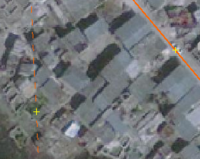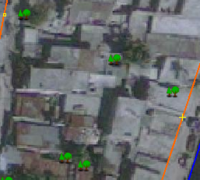JA:WikiProject Haiti/Mapping Coordination
- WikiProject revisions: Revisions to front page of WikiProject completed = everything consolidated into a single table or moved to different pages. --Ceyockey 16:34, 30 October 2011 (UTC)
- WikiProject revisions: Revisions are underway (slowly) to revise the WikiProject from crisis-response to mapping-as-usual mode. --Ceyockey 16:34, 30 October 2011 (UTC)
- On-the-ground: Fourth deploy write-up - 2010-09-08
- On-the-ground: HOT Mission 3 complete [1] - 2010-06-28
- Hot website launched with blog category 'Haiti' - 2010-05-??
全般
何をマップする必要がありますか?
WikiProject_Haiti/Tasks_and_Ideas#Mapping Tasks を参照してください。
マップするには?
OpenStreetMap でのマッピングをこれから始めるなら、チュートリアルと詳しい説明が ここ にあります。
- トレース済みの street に street 名 を追加する
- JOSM の使い方 を見て、USGS マップのデータにもとづいた street 名をつけます
- 地震後のイメージからトレースする (Imagery and data sourcesを参照ください)

- Perry Castaneda Library Haitiからもっと古い地図を (PaPの外は沢山ある)
- New York Public Libraryからもっと古い地図を (PaPの外は沢山ある)
衝突を避けるため、アップロードは頻繁にしてください! JOSM を使っている場合は、衝突をさけるためにデータの更新も頻繁におこなってください!
データ取得
- 他のデータソース(ベクターとラスター)を取得して名前や特徴等のために自由にさせること。ポルトープランスの外のイメージでも。
- ハイチの地理をよく知っている方とつなげること。
- Tim Watersの地図を歪む道具を使って地図のイメージを歪むのに手伝いましょう。いったん地図が歪まれたら、JOSMのベースマップとして使うのに道具の「Export」のタブからWMSリンクがコピー出来ます。
トレース/マッピングの協力
こちらへ自分の名前を追加してください。
こちらへマッピングを協力するのにosm-matrixのオンラインツールがあります。
こちらへ共有しているスプレドシートがあります。
Diff Reports
- Diff Reports (useractivity) newest to oldest:
- (updated frequently and upon request by Gary68; smaller areas needed?)
Notes
Notes can be used to:
- report possible errors in OSM data
- request verification of features (e.g. building collapse, refugee presence)
- request completion of features (e.g. waterway extension)
Error Reports
There is a big list of different error reports from gary68 tools on this page. Will be updated a few times a day.
- now a gpx-file with the error-reports can download for the direct import in the osm-editors. thanks to FlaBot. --Jan Tappenbeck 23:34, 26 January 2010 (UTC)
Best Practices
- Mapping individual buildings
- Don't map individual buildings unless you have access to hi-res imagery, i.e. Googles aerial imagery
- Don't map individual buildings unless they are large and free standing (and unless you have access to fairly precise imagery)
- In areas with densely packaged small buildings do map an area tagged with landuse=residential
- Trees
- Don't map individual trees unless you have access to hi-res imagery, i.e. Googles aerial imagery
- Tagging highways
- Don't tag with highway=living_street if you trace from satellite or aerial imagery. In urban areas like Port-au-Prince or Jacmel, highway=residential is usually appropriate.
Proposed best practices
for consideration - rewording - acceptance or rejection
- When looking at an area new to you, make sure to move the imagery to best match the existing mapped information rather than diving into moving mapped elements to match the imagery.
- I think that well aligned imagery is now available: Googles imagery, WorldBank imagery, NOAA imagery. I feel that best practice should be to actually allign mapped elements with hi-res imagery from Google, WorldBank and NOAA, and to follow your principle in all other cases. Gubaer 17:38, 30 January 2010 (UTC)
- I agree with you ... the trouble I have is in distinguishing well aligned from poorly aligned imagery. It would be useful to have that kind of meta-data available when you are picking an image set to use. The whole process of preparing an image set for general use is pretty much a black box for the majority of mappers, I think. Thanks for considering this. --Ceyockey 18:30, 30 January 2010 (UTC)
- I think that well aligned imagery is now available: Googles imagery, WorldBank imagery, NOAA imagery. I feel that best practice should be to actually allign mapped elements with hi-res imagery from Google, WorldBank and NOAA, and to follow your principle in all other cases. Gubaer 17:38, 30 January 2010 (UTC)
- When in doubt about whether to use highway=residential or another highway value, use highway=unclassified. Avoid using highway=road.
Requests from Responders
Responders on the ground are making requests for specific thematic and geographic data sets. Please specify time, who, and where the request was made. If possible, please communicate with them if the request has been filled. Think of this a lightweight ticketing system.
- "Street names in PaP are critical, streets around the airport and around Delmas and Carrefour Feuilles are critical. So are streets in Carrefour. POIs are not so critical have most of the essential ones already and we are mostly getting street addresses which can be found if we have the streets. Would also be nice to know whether block numbers are increasing or decreasing on streets.", Ushahidi, Anna H Schulz <Anna.Schulz@tufts.edu>, via CrisisMappers, 20100118
Who's Helping
Add your name here...
Also see who's editing! (... which BTW shows only mapping history of "greater PaP" area. Whole Haiti is shown here ... but that's too large of an area to show editing history for. ... Maybe the mapping history should be divided into, say, four segments? ... And yes, I assume that this should be put on the talk page -- but it's easy to move. ... Wanted to put it here since there hasn't been any acticity on the talk page since January and I have no idea if anyone follows that. ... I'll move this to the talk page as soon as someone's commented it here... or I've asked about this on an email list or something... -- Jaakko Helleranta)
Places
Cities outside Port-au-Prince. Especially important in the weeks ahead, as the response expands outside the capital
Potlatch links below can be used as bounding-box URLs in JOSM; the Town/City node links provide access to place meta-data and an alternative starting point for navigation
- Cap-Haïtien, bbox=[-72.2525,19.7135,-72.1631,19.7717]
- OSM |working on
- Saint-Marc, bbox=[-72.7372,19.08617,-72.67379,19.1296]
- OSM |working on
- Saint-Marc: Potlatch | Town node
- Les Cayes: Potlatch | Town node
- Port de Paix: Potlatch | City node
- Gonaives: Potlatch | City node
- I've added the '93 CIA map data, please bring it up to date - AndyGates.
- Still very much to do! Check http://www.openstreetmap.org/?way=48431814
- Street names added from MINUSTA city map according to this diff.
- Jacmel: Potlatch | Town node
- Street names added from MINUSTA city map according to this diff.
- Leogane: Potlatch | Town node
- Petit-Goave: Potlatch | Town node
- Street names and POI from MINUSTAH added; detail-mapped from NOAA 18 Jan aero imagery.
Entire country
- Haiti, bbox=[-74.76,17.78,-71.43,20.26]
- OSM |working on
The bbox shown covers all of Haiti including territorial waters. This can be used as a "bbox predicate" in Xapi queries to retrieve a .osm file for a single tag value (an Xapi limitation), such as amenity=hospital; the url for this query would be http://xapi.openstreetmap.org/api/0.6/*[bbox=-74.76,17.78,-71.43,20.26][amenity=hospital]. See the Xapi article for more information.
- Even look at these Map.
Administrative units and boundaries
Haiti is organized into 10 Departments which are further divided into 41 Arrondissements and 133 Communes (from Wikipedia). Communes are further divided into sections. For the Haiti Earthquake mapping pcodes have been associated with various relations; pcode:1 for Departments, pcode:2 for Communes and pcode:3 for Sections.
For a list of OSM Relations for the boundaries that have so far been imported/created see WikiProject_Haiti/Status/Boundaries
Administrative boundaries and invalid relations created with Gary68's script boundaries.pl [2][3].
http://yellowcabcar.de/osm_haiti/boundaries.html
An admin boundaries shapefile can be downmoaded at http://labs.geofabrik.de/haiti/boundary-shapefile/ It countains proper polygons for all boundary=administrative objects (whether closed ways or closed multipolygons), including the national borders of Haiti and the Dominican Republic. The shape file does not contain such administrative areas that have an invalid geometry in the current OSM data set. This shapefile is not updated automatically. If needed ask to
Features
Lists of Tags
- Humanitarian_OSM_Tags has a discussion of tags and current assessment of tags - please contribute.
Specific Tags
- Bridges using bridge=collapsed for damaged bridges. Particularly wanted 17:00 GMT 2010-01-14. (Gene Longenecker, pressumably Region IV co-ordinator for NEHRP/FEMA stated a need for a 'bridge shape file layer'). These are now provided in the roads layer thanks to Geofabrik, but need mapping.
- Spontaneous camps using tourism=camp_site and refugee=yes. GIS practitioners at the United Nations Office of Coordination of Humanitarian Affairs (UNOCHA) mentioned the following mapping requirement: "NEED to map any spontaneous camps appearing in the imagery with size in area". The given tags tags would fully specify this, and be rendered immediately
- Buildings using building=collapsed or earthquake:damage=collapsed_building primarily, though other tags are used -- see Humanitarian_OSM_Tags.
- EU JRC/Ithace and UNOSAT are producing damage assessment maps.
- added a bunch of damaged points derived by Ithaca by photo interpretaion:
- Tag used:
- earthquake:damage=collapsed_building
- earthquake:damage=spontaneous_camp
- earthquake:damage=damaged_infrastructure
- earthquake:damage=landslide
- zvenzzon made a map that shows tag usage for the tags above: http://zvenzzon.mine.nu:81/map.html
- earthquake:damage=spontaneous_camp should soon appear in osmarender too
- http://haiti.openstreetmap.nl is a minutely updating Mapnik render that shows is too.
- Road blockage
- barrier=obstacle for small obstacles on the highway which may be visible in GeoEye imagery.
- impassable=yes for a stretch of road which is impassable due to multiple obstacles or a debris field.
Localisation
The primary language of Haiti is French; additionally, there is much discussion of Haitian Creole, with potential tagging as name:ht=* for Haitian Creole names. Sources may cite names of facilities, infrastructure in French.
A glossary of French topographical terms may be found here.
Note that name=* stands for "the default name, used locally". Multilingual support may be of value, this can be achieved through multiple use of name=*, name:ht=*, name:en=*... tags and translating as appropriate to populate multilingual variants as applicable.
Also I would anticipate that multinational support will be providing aid from Latin America as well, e.g. Spanish - name:es=* and Brazilian UN peacekeeping troops name:pt=* to support Portuguese.
Effort should be made to include properly accented characters. Users who don't normally use accented characters can cut-and-paste these from other features, or look up how to use a different character set with your keyboard (example).
JOSM presets
See JOSM presets for the Haiti Earthquake Response.
Additional Ideas
- large open spaces to serve as relief operation areas
- food distribution points
- How to map tent hospitals, hospitals in ships in the harbour, drinking water production places?
- Map village names from Public Domain CIA Maps. Sample WMS link suitable for JOSM OpenStreetMap Editor. Important for orientation.
- Water and sanitation features are crucial
- Someone should check at least all the main roads (red and yellow) if all the bridges/fords are marked as such. Not only in the Port-au-prince area, but everywhere. And if you find a bridge without a mapped river below, please mark a bit of the river as well.
Fix errorlogs for better data
Frequently updating errorlogs you can find here. The C06-Check find river and streets crossing and having the same layer. Normaly the street has a bridge over the river. Tagging the bridge is important because after the eathquake every bridge can be damaged or out of use. So fix the bridges meaning making better data for routing. Quite a lot of minor crossings are fords, please use highres imagery to identify and tag (make a crossing node and tag just that node with highway=ford).

